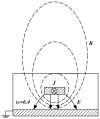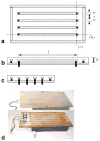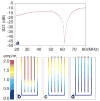Planar strip array (PSA) for MRI
- PMID: 11283996
- PMCID: PMC1941687
- DOI: 10.1002/mrm.1090
Planar strip array (PSA) for MRI
Abstract
Parallel, spatial-encoded MRI requires a large number of independent detectors that simultaneously acquire signals. The loop structure and mutual coupling in conventional phased arrays limit the number of coils and therefore the potential reduction in minimum scan time achievable by parallel MRI tchniques. A new near-field MRI detector array, the planar strip array (PSA), is presented that eliminates the coupling problems and can be extended to a very large number of detectors and high MRI frequencies. Its basic structure is an array of parallel microstrips with a high permittivity substrate and overlay. The electromagnetic (EM) wavelength can be adjusted with the permittivity, and the strip lengths tuned to a preselected fraction of the wavelength of the MRI frequency. EM wave analysis and measurements on a prototype four-element PSA reveal that the coupling between the strips vanishes when the strip length is either an integer times a quarter wavelength for a standing-wave PSA, or a half wavelength for a travelling-wave PSA, independent of the spacing between the strips. The analysis, as well as phantom and human MRI experiments performed by conventional and parallel-encoded MRI with the PSA at 1.5 T, show that the decoupled strips produce a relatively high-quality factor and signal-to-noise ratio, provided that the strips are properly terminated, tuned, and matched or coupled to the preamplifiers. Magn Reson Med 45:673-683, 2001.
Copyright 2001 Wiley-Liss, Inc.
Figures














References
-
- Sodickson DK, Manning WJ. Simultaneous acquisition of spatial harmonics (SMASH): fast imaging with radiofrequency coil arrays. Magn Reson Med. 1997;38:591–603. - PubMed
-
- Pruessmann KP, Weiger M, Scheidegger MB, Boesiger P. SENSE: sensitivity encoding for fast MRI. Magn Reson Med. 1999;42:952–962. - PubMed
-
- Roemer PB, Edelstein WA, Hayes CE, Souza SP, Mueller OM. The NMR phased array. Magn Reson Med. 1990;16:192–225. - PubMed
-
- Wright SM, Magin RL, Kelton JR. Arrays of mutually coupled receiver coils: theory and application. Magn Reson Med. 1991;17:252–268. - PubMed
Publication types
MeSH terms
Grants and funding
LinkOut - more resources
Full Text Sources
Other Literature Sources
Medical
Research Materials
Miscellaneous

